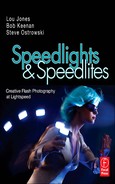Book Description
Canon Speedlites and Nikon Speedlights are small, off-camera flashguns that can provide big results - if you know how to use them properly. Acclaimed Boston photographers Lou Jones, Bob Keenan and Steve Ostrowski guide you through the technical and creative aspects of how to get the most out of these powerful tools in this indispensable guide, packed full of inspirational images and comprehensive diagrams of the lighting set ups used to capture them.
They are significantly more advanced, lighter and considerably cheaper than a standard flashgun, and have many advantages. They are small (and cheap) enough that a number can be carried in your kit, and they can be used in combination, triggered wirelessly. They use through-the-lens (TTL) metering, which allows you to use the in-camera LCD and histograms to calculate the required power/direction, rather than havng to use a light meter or trial and error. They use proprietary, dedicated technology (from Canon and Nikon) that means there are no compatability issues.
Getting the most out of them, however, remains a mystery - most photographers still just use their speedlights in the same way as a standard flash gun. This is where this book comes in.
Table of Contents
- Copyright
- Traveling at Lightspeed
- Speed of Light
- Color Coding Key
- Ten Tenets of TTL Speedlights
- Introduction
- The Authors
- 1. One Light
- TTL Flash
- TTL Exposure System
- TTL Flash and Exposure: A Primer
- TTL Flash and Aperture
- TTL Flash and Distance
- TTL Flash and Subject Size
- TTL Flash and Shutter Speed: Synchronization
- TTL Flash: Flash Anatomy and Features
- Exposure Compensation
- Philosophy
- Characteristics of Light: Analysis and Decisions
- Bounce Flash: Direction and Quality of Light
- 2. Two Lights
- Light
- Lighting
- Wireless
- Wireless TTL: Remote/Slave Flash
- Wireless TTL: Additional Trigger Devices Need Not Apply!
- Nikon SU-4 Mode
- Wireless TTL Transmitters: Master
- Wireless TTL Receivers: Remote/Slave
- Wireless TTL Communication: Line of Sight
- Wireless TTL: Channels
- Wireless TTL: Privacy
- Wireless TTL: Basic Settings for Master and Slave
- Wireless TTL: Controlling Exposure and Contrast
- Manual Flash
- Equipment, Accessories, Products
- Summary
- Lighting Diagrams
